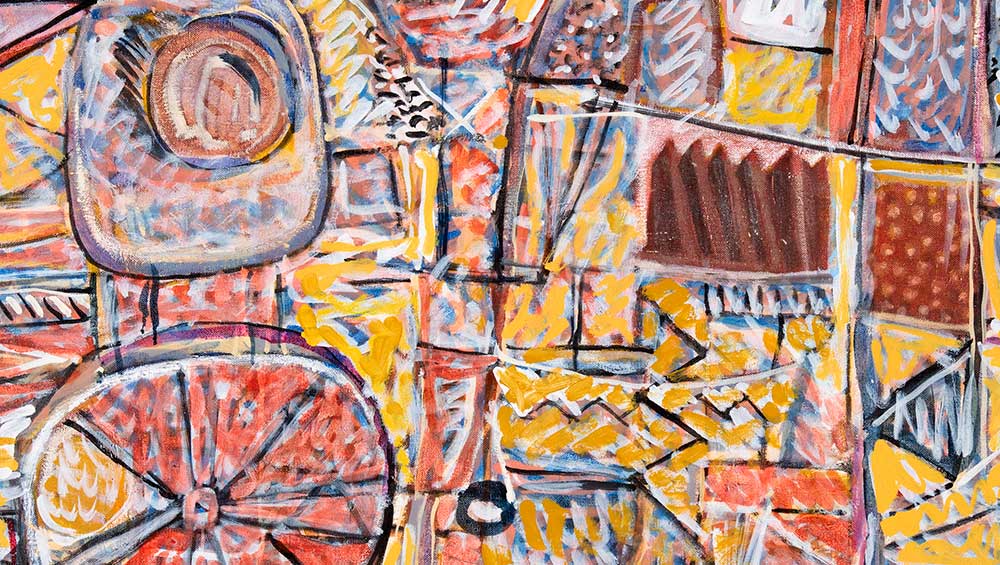
Wayne Eager, Allegory I, 2023 (detail). Oil on linen, 133 x 95 cm. Image © the artist.
by JANET McKENZIE
Wayne Eager (b1957) grew up in the Yarra Valley near Melbourne. His parents were both artists and built their family house from mud bricks on bushland, near Lilydale. Being immersed in the natural environment meant he fostered a close relationship with the Australian bush and had a heightened awareness of its unique beauty. In 1973, a school trip to Central Australia precipitated a fascination for the vast magical interior of the Australian continent. In 1976, he enrolled at the National Gallery School, later the Victorian College of the Arts, Melbourne. From an early age, Eager developed a rhythmical layering of linework, a gestural abstraction akin to the Scottish-born Australian artist Ian Fairweather (1891-1974) who was a key figure in abstract art in Australia.
Close friendships were formed through art school and in to the 1980s. Eager made a trip in 1981-82 with David Larwill and Peter Ferguson, first to London, and then to Paris, Madrid, Amsterdam, Copenhagen and Switzerland. They took in exhibitions of Paul Klee, Pablo Picasso, Marc Chagall and Jean Dubuffet, before heading to Greece, Turkey and Morocco. The impact of this trip was profound and, 40 years on, can still be seen in his lyrical abstract painting.
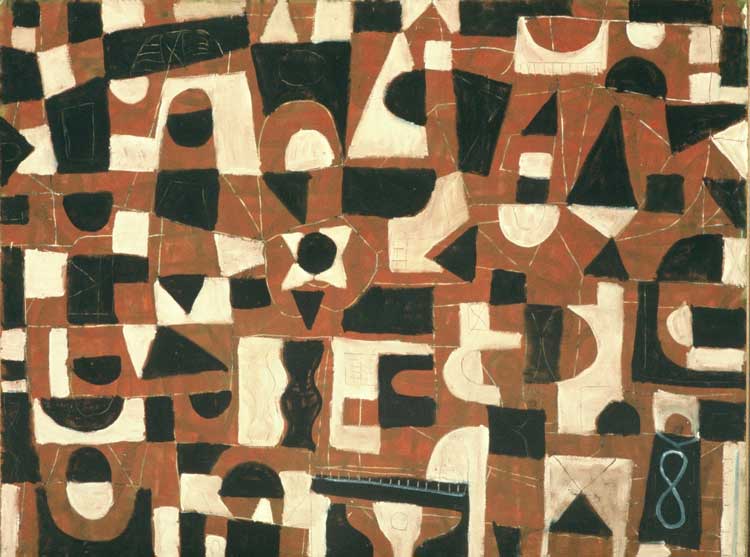
Wayne Eager, V8, 1988. Oil on masonite, 91 x 122 cm. Image © the artist.
Returning to Melbourne after the overseas travel coincided with the establishment of the Roar Studios. This was Australia’s first artist-led space in the inner Melbourne suburb of Fitzroy and existed for about 20 years. The founding artists were young and rebellious, and they wanted to expand art practice beyond the confines of the hard-edge abstraction, minimalism and conceptual art that dominated the art scene. Eager says: “It was psychologically beneficial to all of us, a ‘base camp’; a group association and a meeting ground, to provide contrast to the isolation of work in the studio, and it helped us to establish links with commercial galleries that had seemed distant and remote.” Roar Studios was one of the few vanguard groups to emerge in Australian art in the late-20th century.
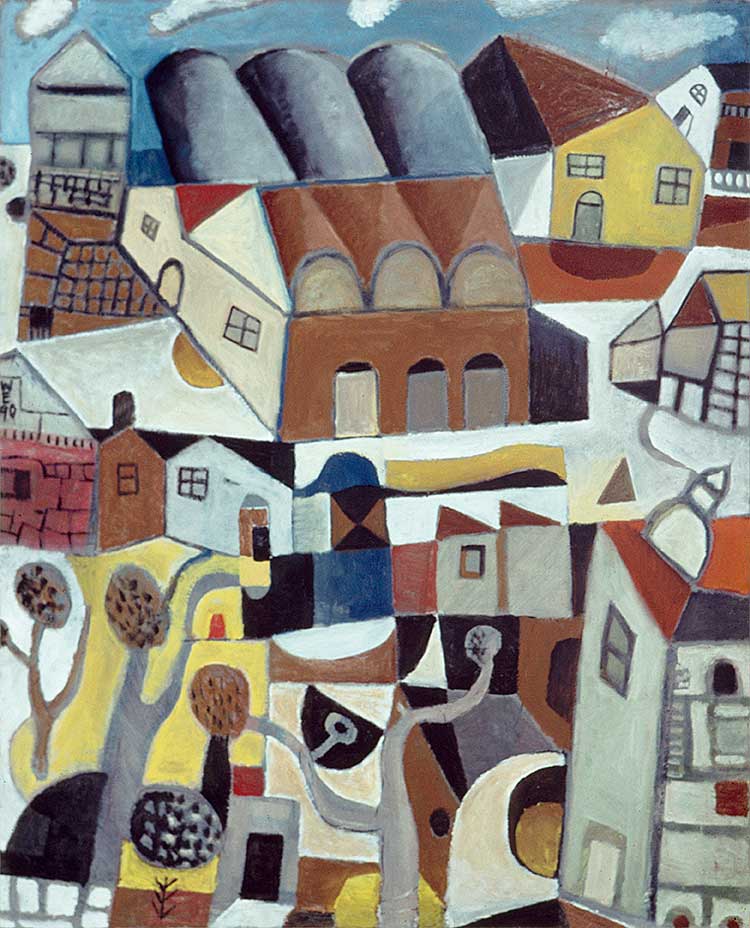
Wayne Eager, Buildings II, 1990. Oil on linen, 122 x 90 cm. Image © the artist.
Perhaps the most significant experience in the development of the careers of Eager and Larwill was the decision to leave urban Melbourne in 1990, and travel to Alice Springs in Central Australia. They stayed there for three months and were given introductions to a number of remote Aboriginal communities: Papunya, Kintore and Yuendumu. Then came a trip to Darwin, where Eager stayed on at the Kakadu National Park, where his brother worked as a scientist, for four months. The paintings made there were exhibited in Melbourne on his return. Subsequently, Eager and his partner, Marina Strocchi, moved to Central Australia in 1992, where a three-month project led to them making a major contribution to Aboriginal arts programmes for almost 30 years.
Janet McKenzie: Can you recall your first encounter with Australian Aboriginal art?
Wayne Eager: I remember bark paintings at the old National Gallery of Victoria Museum, in Swanston Street, Melbourne. In 1968, the new NGV opened in St Kilda Road, and I often visited. I was always interested in the organic quality of the mark-making and the conviction of the storytelling on a two-dimensional surface. But it wasn’t until the desert “dot” paintings began to emerge that my interest intensified.
In 1982, Gabrielle Pizzi approached Roar Studios to exhibit a show of Western Desert paintings. Many of the artists were against her proposal, deeming it an exploitation of Aboriginal culture. A few of us stood up for the proposal on the grounds that it was a good thing to promote Aboriginal art and culture to the wider art world, as it had been relegated to a hidden history of anthropological relics for far too long. Her exhibition at Roar Studios was her first show of Aboriginal Art in a public space. She went on to open her own gallery in Melbourne, exhibiting a range of Aboriginal art from across Australia.
JMcK: What prompted your seven-month trip to Central Australia with David Larwill in 1990?
WE: An increase in exhibitions of Western desert painting in the wider world led to our growing interest. A friend, John Corker, who helped to set up Roar Studios in 1982, had moved to Alice Springs in 1983 to work with the Aboriginal Legal Aid service.
In Central Australia, I was mesmerised by the bright light and colour in the wide, open landscape. We visited the Papunya Tula Artists Gallery on an almost daily basis, travelled around country and visited various communities, before moving on north towards Darwin.
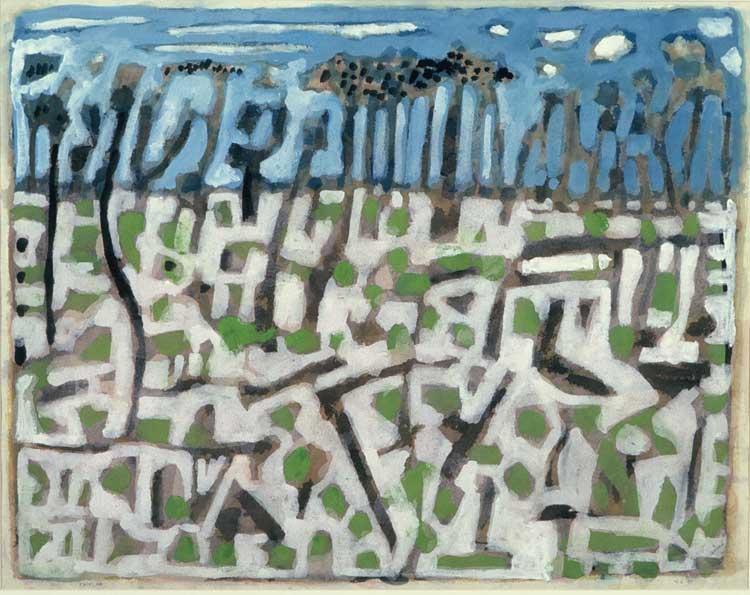
Wayne Eager, Regrowth after fire Kakadu, 1991. Gouache on paper, 55 x 70 cm. Image © the artist.
My brother, Robert, worked for the Commonwealth Scientific and Industrial Research Organisation and was manager at Kapalga Research Station in Kakadu National Park, when I stayed for four months. I set up a table, gouaches and paper and attempted to paint in relation to the surrounding bush landscape, which was a total contrast to my surroundings in the inner-city studios where I lived for eight years. When I returned to Melbourne, I set out to paint some larger works in oil and try to interpret my experiences of the Northern Territory, of both desert and the Top End region. The landscape theme dominated my paintings for the next five years, where I tried to capture something of the expansiveness of the Northern Territory countryside.
JMcK: What led to your permanent move to Central Australia?
WE: Marina Strocchi and I had been in a relationship for six months when, in January 1992, she made a trip to Alice Springs and with a couple of contacts. She was dropped at Haasts Bluff for two weeks, conducting art workshops and participating in local activities. This was followed by a “reconnaissance” trip by three of the Haasts Bluff women, to Melbourne, where they visited art galleries, artist’s studios (including mine) and Marina’s work activities. In June that year, she was formally invited by the Ikuntji community council to work for three months in the community; to help set up and run a women’s centre in an empty building.
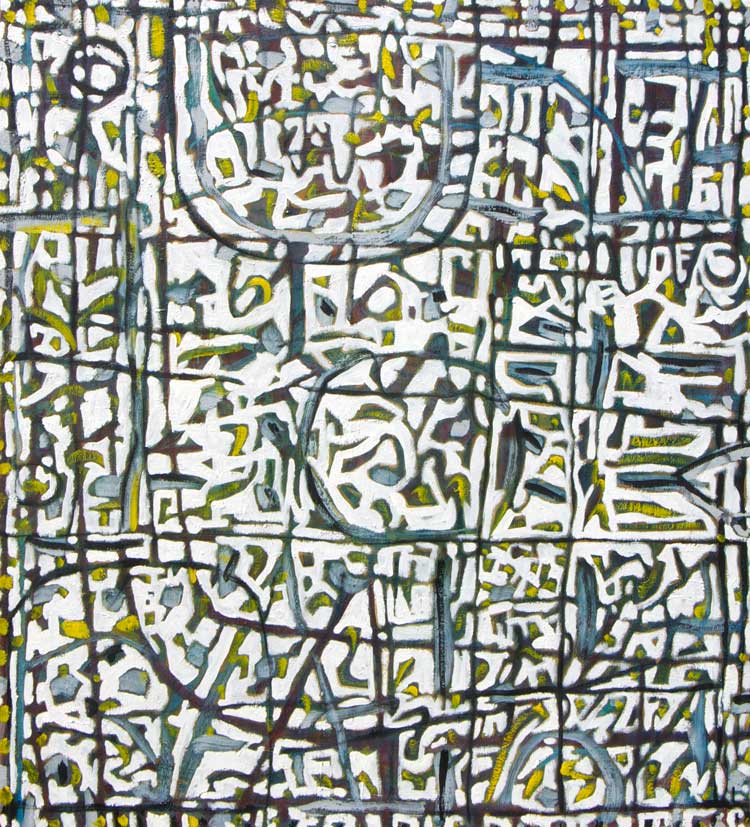
Wayne Eager, Sufi, 2014. Oil on linen, 153 x 158 cm. Image © the artist.
As soon as we arrived at Haasts Bluff, we became totally engrossed in our new surroundings, making friends and becoming involved in community life. Marina was employed as manager of the new Ikuntji Women’s Centre, and I helped on a voluntary basis. Painting immediately became the main activity, and in a little over a year, with changes to the funding procedure, the centre officially transformed into the Ikuntji Art Centre.
Marina’s background included: silk-screen printing at Red Letter, Fitzroy, and working in community arts; running art classes for unemployed programmes, disabled people and migrant women; plus running a business, selling her own hand-printed fabrics. This was useful knowledge and experience for her new job. My experiences at Roar Studios and 10 years of painting and exhibiting my own work complimented her skills.
There were many obstacles to overcome in developing the art centre: a bureaucrat in Alice Springs told us that we should abandon the painting practice in the community, as the art market was already full of “dot paintings”. Meanwhile, artists carried on happily, each developing innovative and unique approaches to depictions of their own stories. We maintained that the market followed the art, not the other way around.
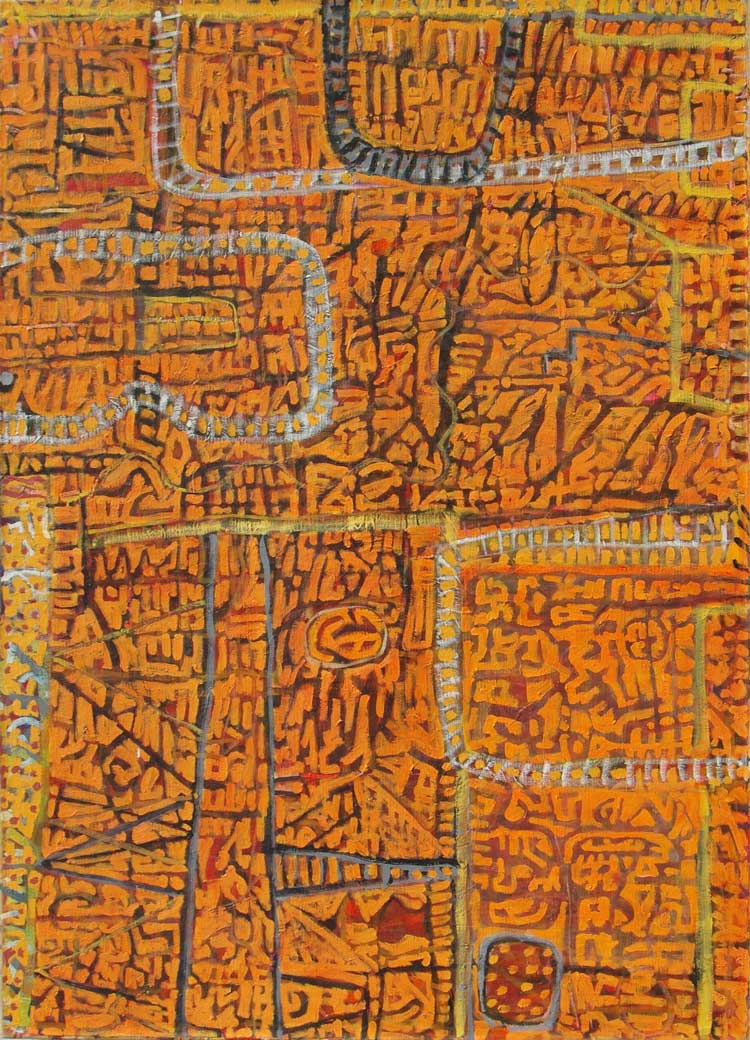
Wayne Eager, Sandhill Country, 1995. Oil on linen, 168 x 122 cm. Image © the artist.
JMcK: Can you recall the social imperative you felt to work under extreme and remote conditions?
WE: The conditions were harsh, and we were a long way from family, friends and the comforts of city living, but we felt a warmth and generosity and were accepted there. We were taken out on many bush trips by Joe Multa Tjakamarra and his family, camping in pristine wilderness. The kindness and acceptance we were shown instilled in us a deep feeling of responsibility, and an obligation to do the best we could to help the artists and art centre to be a success financially and to bring a sense of pride and accomplishment for the artists. The painting of stories is a way of strengthening and preserving culture, helping the artists’ mental conviction and health, while giving to the world a unique visual image to be enjoyed and experienced into the future.
JMcK: From April 1996, you worked for almost 10 years as a field worker for the Papunya Tula Artists. Can you describe your day-to-day work there?
WE: I worked for four years full time as a field worker for PTA, and then intermittently over the next five years, with occasional trips until 2019. When I first began, alongside fellow field worker, Paul Sweeney, it was exhilarating to be working in the service of such a dynamic group of artists, including some of the PTA greats, such as Mick Namarari Tjapaltjarri, Yala Yala Gibbs Tjungurrayi, Ronnie Tjampitjinpa and Turkey Tolson and a group of women including Makinti Napanangka, Nyurapayia Nampitjinpa, Ningura Napurrula, Tjunkiya Napaltjarri and Wintjiya Napaltjarri, who were only just beginning to paint for PTA. I knew most of these women already from the Haasts Bluff/Kintore Women’s painting project of 1994-1995.
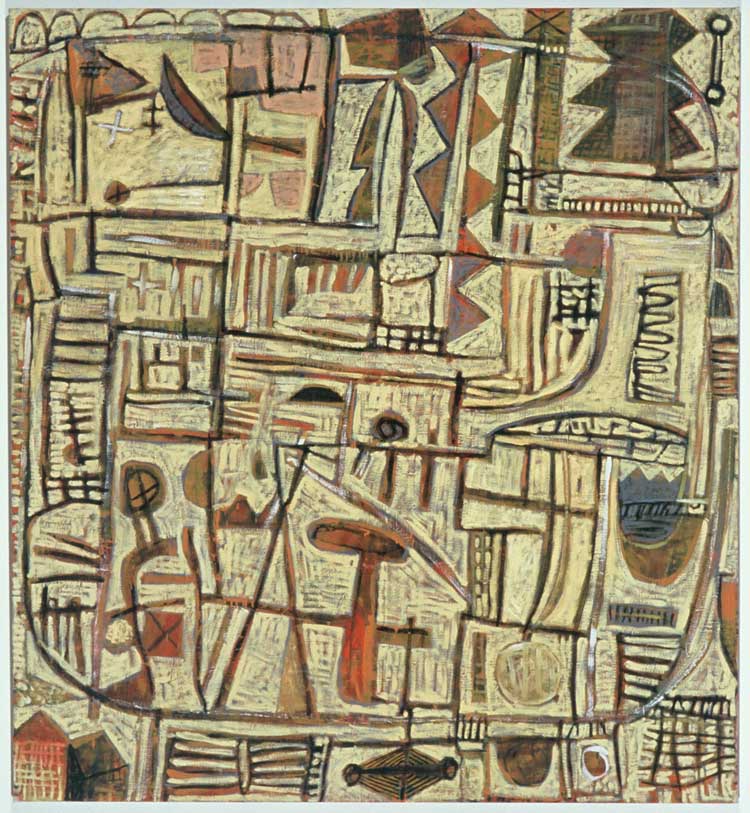
Wayne Eager, Gadgets, 2002. Oil on linen, 200 x 183 cm. Image © the artist.
The Kintore art shed, which had mainly been used for storing the materials and preparing canvases to hand out to artists, now became a studio where many of the artists came to paint. There was a vibrant atmosphere at the art shed/studio, ranging from chaotic and noisy to a quietly working group in good humour with a background of traditional or church gospel singing. It was always inspiring to witness the diverse range of paintings in progression; each artist developing and exploring the visual dynamics in the process of enhancing ancient stories. Assisting these artists was always enjoyable and, I felt that my enthusiasm was appreciated in return. Other aspects of the daily routine included stretching and priming canvases, mixing paints, cataloguing and paying for finished paintings as well as assisting artists who painted at their homes. I was always aware of how privileged I was to have known and befriended such incredible personalities, who have, as is now widely acknowledged, made a huge contribution to art.
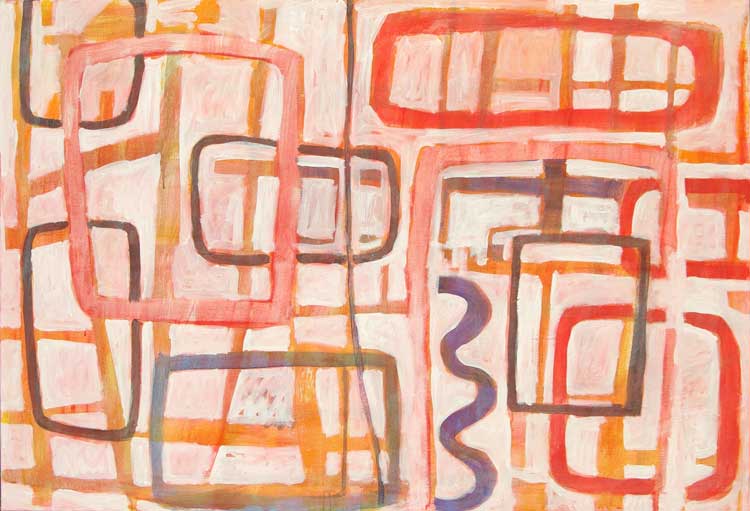
Wayne Eager, La Perouse III, 2009. Oil on linen, 137 x 200 cm. Image © the artist.
JMcK: Is it possible to describe your choices and to view the Indigenous art industry as you experienced it?
WE: In the early 1990s, there were just a few art centres concentrating on painting, while the majority focused on craft and tourist curios. As outsiders, Marina and I recognised the wealth of talent, which was particularly strong among the older people who were mostly bush-born and grew up in the hunter/gatherer lifestyle. This contrasted with what appeared to be a limited market and no vision for any expansion of this. Some people, including Marina and myself, recognised the urgency for change, as many of these “potential” artists were already quite elderly, and assistance was needed to address this drive to paint, if for nothing else, than to help the spiritual wellbeing of artists while confirming and strengthening cultural knowledge; market or no market.
From the moment we arrived at Haasts Bluff, in 1992, Marina and I were confronted with, and felt compelled to address, this strong desire, or drive to paint, by people in that community. In the late 1990s, the dilemma I faced as field worker for PTA, was the juggling of the enormous wealth of talent in the communities, as opposed to a tepid market; artists were paid on completion of a painting and there was a limit to the amount of stockpiled work that could be carried by the company. There has always been pressure on art centres, as they are the main activity generating income for Aboriginal communities and, in many cases, the only income apart from government welfare.
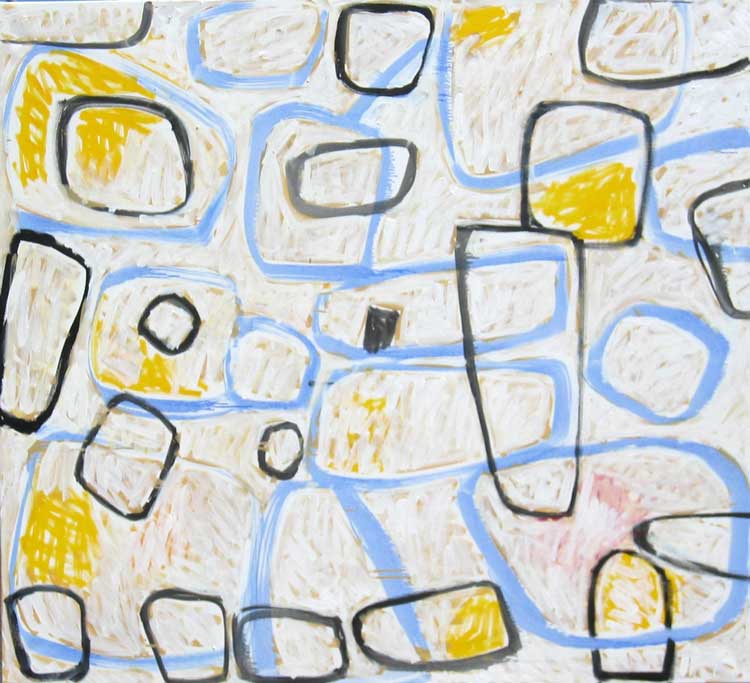
Wayne Eager, Straddle I, 2006. Oil on linen, 152 x 168 cm. Image © the artist.
From the mid-90s, the Sotheby’s Aboriginal art auctions, conducted by the visionary Tim Klingender, began to bring about a greater interest of the early Papunya boards, and this created a widespread interest and a burgeoning market for the new desert paintings. By the early 2000s, the market had grown enough to accommodate a swathe of new art centres over the desert, including in the Aṉangu Pitjantjatjara Yankunytjatjara lands in South Australia and the Western Desert group in Western Australia.
The annual “Desert Mob” exhibitions held at the Araluen Arts Centre, in Alice Springs, brought an appreciation of desert art to a wider audience. I remember the Desert Mob shows from the early 1990s, which were dominated by trinkets and craft, with only a few art centres showing paintings. Ten years later, Desert Mob was transformed to a predominantly painting show, a celebration of the new art centres.
From 2009 to 2016, I was employed by Aṉanguku Arts, South Australia, to conduct regular painting workshops on the Aṉangu Pitjantjatjara Yankunytjatjara lands art centres plus pop-up workshops at other places, including Coober Pedy, Oak Valley and Ceduna. For the three decades that Marina and I lived in the Northern Territory, we continued our own creative practice, painting and exhibiting, acutely aware of the necessity of maintaining a distinct distance between the two occupations. It was exciting to live and work among this transformation in the art world.
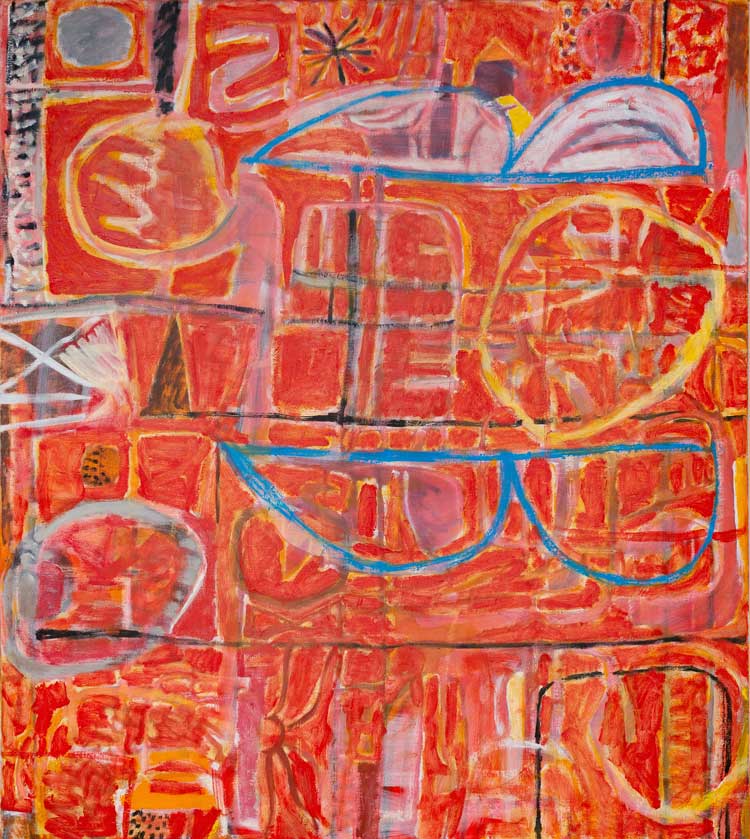
Wayne Eager, Red Town, 2018. Oil on linen, 138 x 122.5 cm. Image © the artist.